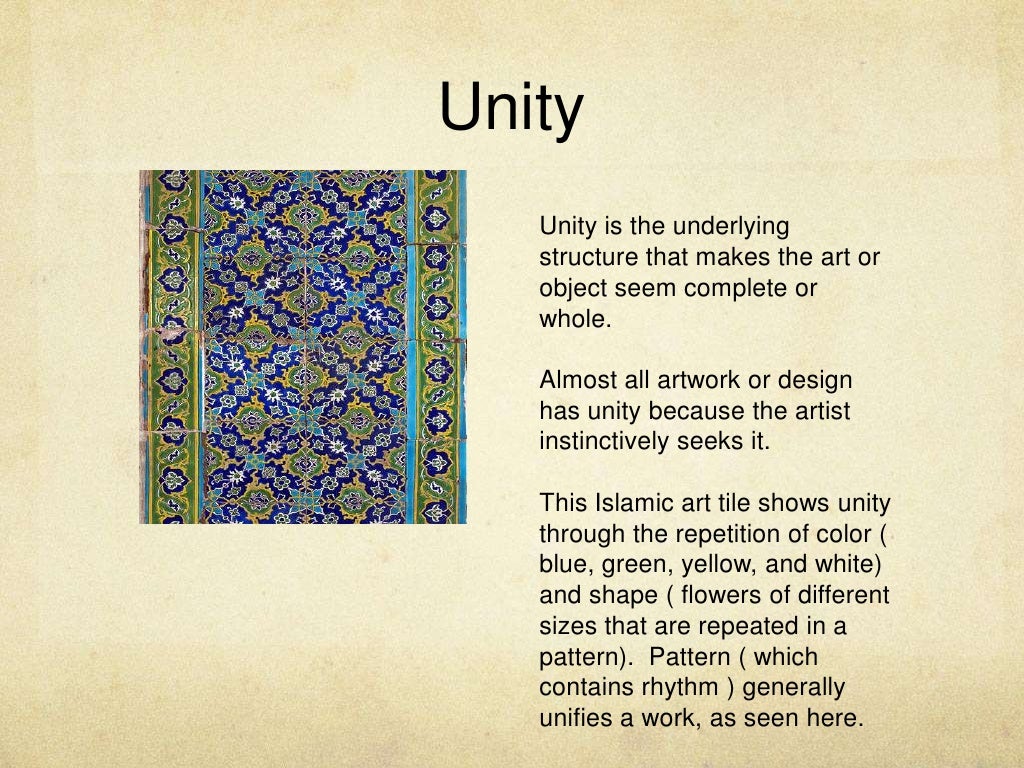
When designing something, it’s essential to remember the overall impact you want your work to have and how your design elements will come together to achieve that effect. The unity principle of design is crucial because it helps to create a cohesive visual experience. 1) Helps to Create a Cohesive Visual Experience You may ask, ” Why is the unity principle of design important?” Let us give you the right answer.
#Unity definition in principles of design how to
Read More: How to Build an Effective Product Design Team in 2022 Why the Unity Principle of Design Is Important? It can be achieved by establishing one dominant element and positioning all other stuff around it about that central focal point. The principle of unity refers to a sense of wholeness or oneness. For example, using bolder text than usual or making certain items larger than others (such as an image). This principle involves highlighting essential elements within your layout to stand out.

#Unity definition in principles of design windows
The rhythm principle of design can also refer to the repetition of forms within a room, like if you have window frames that repeat across several windows or doors.

Rhythm is the repetition of elements throughout space to create a unified aesthetic. The movement principle of design is about creating an environment that feels like it’s moving, whether using contrasting colors, repeating patterns, or something else entirely. Movement is essential because it’s the key to creating a sense of flow and continuity in a space. You need to ensure they’re communicating with each other in a way that makes sense and is easy for people to understand. Often, this approach can feel like a way to get creative any rules or constraints do not limit you.īut if you want your product to be successful, you must think about how the visual elements of your design work together. When designing a product, it’s tempting to throw everything at the wall and see what sticks. Contrast is used to draw attention to certain parts of a room or furniture. If you use an ornate pattern with a simple pattern, it also creates contrast. The contrast principle of design can be created using different materials, textures, or colors.įor example, using a dark color on one wall and a light color on another creates contrast. The principle of contrast is the difference between elements in a space. This makes things feel more extensive because they’re more noticeable and stand out more. To make it seem more significant, use large furniture and accessories instead.Īnother way to use scale is by using a high-contrast color scheme. For example, if you want to make a piece of art seem smaller than it is, then you’d use small furniture and other accessories around it. You can use a scale to make something look larger or smaller than it is. Scale is about the size of a piece of furniture, art, or other design elements. The best way to achieve balance? It’s up to you! 2) Scale It’s about ensuring that the parts of your design work together to create an even whole and that no one part stands out more than any other.īalance can be achieved in many ways: through color (by using complementary colors), through shape (by pairing shapes with similar or different proportions), through size (by making one element larger or smaller than the others), and so on. This principle is all about creating a sense of equilibrium in your design. There are seven common principles of design that are used in many different fields, from graphics to interior design. What Are the Seven Common Principles of Design? From how people interact with your company online (through emails or social media posts) to how they respond when they contact you in person at an event or trade show.Help make your brand feel cohesive and consistent across all its materials.When you use this principle well, it can: A good unity principle of design example is when you have an image and text next to each other on your website, both things should add something important to the overall picture you’re painting for your customer, and neither should be unnecessary or distracting. The unity principle of design also means that every element should be doing a little bit to contribute to the whole instead of some elements being more critical than others. This means that all the elements should be working together to tell one story, and it should be easy for people to understand what that story is. The unity principle of design is the idea that all design elements should be unified to communicate effectively.

In this article, we’ll show you how to apply the principle of unity in your designs and which mistakes you should avoid.


 0 kommentar(er)
0 kommentar(er)
